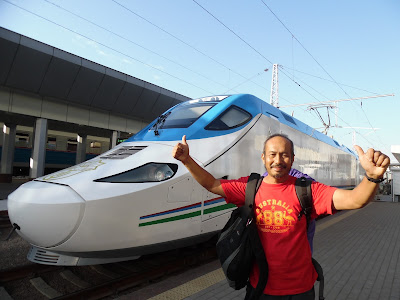Assalamualaikum,
Samarkand - 3J perjalanan dengan keretapi daripada Bukhara. Tambang ialah USD 20 untuk perjalanan siang kelas dua. Merentasi padang pasir tandus dengan berlatar belakangkan, gunung, kawasan ternakan,
perkampungan, tasik dan sungai-sungai kecil. Sekali sekala keretapi berhenti, menurun dan menaikan penumpang. Rumah-rumah tanah liat dan pokok-pokok buah-buahan dimana-mana dikawasan-kawasan perumahan. Seperti epal, anggor, rock water melon, tembikai dan sebagainya.
Ternakan bebiri, kuda disepanjang perjalanan, samaada dalam kumpulan yang besar dan kecil. Jam 12.30pm ZBA sampai di Samarkhand. Cuaca agak panas tetapi tiupan angin sejuk menyebabkan cuaca berada disekitar 18C.
Stesyen keretapi berada dipinggir bandar dan terletak 3 km ke pusat bandar lama Samarkhand. Bus dan teksi adalah pengangkutan utama tetapi daripada bandar lama ke lokasi tumpuan pelancung cuma dalam jarak berjalan kaki.
Samarkhand– the second greatest city of Uzbekistan, the center of Samarkand region. In ancient times city was called as Marakand – capital of tiap Sogdiana. The origin of the name of the city is still unknown. It is supposed that the word
“Samar” is a nakhandme of one conqueror, and prefix “kand” means “the city”, “settlement”. Abu-Raykhan Beruni and Makhmud Kashgari, great scholars of XI century, held opinion that etymology of the word “Samarkand” came
from “semizkent” – “rich population”. In 2001, Samarkand was enlisted into the World Heritage List of UNESCO. In 2008, Uzbek astronomers discovered small planet with the period of circulation around the Sun about four years and in 2010 it was officially
included into the International Catalogue of small planets under the number 210271, — this planet was called as “Samarkand”.
 |
| Bukhara Train Station |
Ternakan bebiri, kuda disepanjang perjalanan, samaada dalam kumpulan yang besar dan kecil. Jam 12.30pm ZBA sampai di Samarkhand. Cuaca agak panas tetapi tiupan angin sejuk menyebabkan cuaca berada disekitar 18C.
 |
| Perjalanan Keretapi Bukhara ke Samarkhand |
Samarkhand– the second greatest city of Uzbekistan, the center of Samarkand region. In ancient times city was called as Marakand – capital of tiap Sogdiana. The origin of the name of the city is still unknown. It is supposed that the word
“Samar” is a nakhandme of one conqueror, and prefix “kand” means “the city”, “settlement”. Abu-Raykhan Beruni and Makhmud Kashgari, great scholars of XI century, held opinion that etymology of the word “Samarkand” came
 |
| World song festival Samarkhad 2015 |
included into the International Catalogue of small planets under the number 210271, — this planet was called as “Samarkand”.
Population is 366 thousand people — Tajiks, Uzbeks, Russian, Jewish and Iranians.
 Official age of the city is 2700 years beginning from the first mentioning in the historical chronicles in 329 BC. But by that time, in the period when Alexander Makedonskiy conquered Samarkand, the city was well strengthened and had rich population, that’s why; it is supposed that the city is older enough. Excavations in the territory of Samarkand certify that from time immemorial people lived in this place thanks to its extremely beneficial geographical location, fresh climate and water source – it was an ideal place for living. Many parts of Avesto, ancient book of Zaroastrians were written in the territory of Samarkand.
Official age of the city is 2700 years beginning from the first mentioning in the historical chronicles in 329 BC. But by that time, in the period when Alexander Makedonskiy conquered Samarkand, the city was well strengthened and had rich population, that’s why; it is supposed that the city is older enough. Excavations in the territory of Samarkand certify that from time immemorial people lived in this place thanks to its extremely beneficial geographical location, fresh climate and water source – it was an ideal place for living. Many parts of Avesto, ancient book of Zaroastrians were written in the territory of Samarkand. Samarkand, and despite the period of obscurantism the city preserved monuments of architecture of various religions. Modern Samarkand treats the representatives of various confessions with care. Besides traditional mosques there are 4 Orthodox churches, 1 Catholic Cathedral, 2 synagogues, 1
Samarkand, and despite the period of obscurantism the city preserved monuments of architecture of various religions. Modern Samarkand treats the representatives of various confessions with care. Besides traditional mosques there are 4 Orthodox churches, 1 Catholic Cathedral, 2 synagogues, 1 Buddhist temple, and prayers-houses of various religion currents. Samarkand, one of the most important geographic key points of Great Silk Road, imbibed many cultures, traditions and art, gathered the most leading masters of the Middle Age. All these were transformed in the
amazing and beautiful monuments of architecture, which still admire the people. When Europe waded through mud on the streets of its cities, Samarkand was paved with stones. Before invasion of Genghizhan people of Samarkand used water supply system while the source of water in many European cities was still the well.
Samarkand is the city of legend, and its stones and walls are like live pages of history, which can be looked through endlessly. Name of Samarkand is connected with the greatest scholars and poets of the Middle Age as Rudakiy, Alisher Navoi, Jamiy, Zahiri Samarkandiy, Ulugbek, Omar Khayam, Avicenna, Rumiy, Beruniy and many others who lighted up the city to all around the world.






















No comments:
Post a Comment